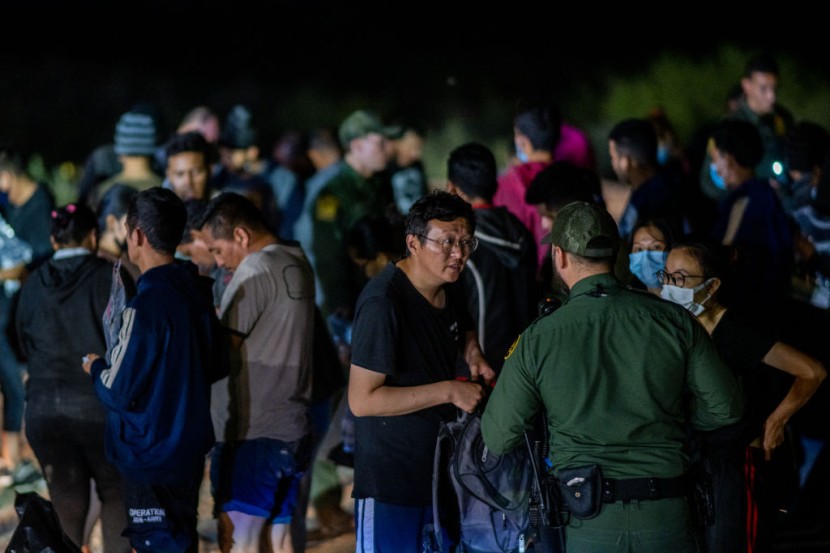Chinese migrants have embarked on a treacherous expedition to reach the United States. Their arduous journey takes them through the unforgiving wilderness of Panama's Darién Gap jungle, only to find themselves in the vast expanse of California's desert.
As they patiently await the opportunity to file their asylum claims, a makeshift encampment accommodates these brave individuals, as per Yahoo News.
Chinese Migrants' Perilous Journey to US

The young Chinese man, Deng Guangsen, appeared lost and exhausted as Border Patrol agents left him at a transit station in San Diego.
Over the last two months, Deng had undertaken a perilous journey from the southern Chinese province of Guangdong to San Diego, crossing seven countries by plane, bus, and on foot, including traversing Panama's treacherous Darién Gap jungle.
Deng, aged 28, expressed his feelings in broken English, saying, "I feel nothing. I have no brother, no sister. I have nobody."
He is just one of many Chinese migrants who have embarked on this challenging route to the United States, a path that has gained popularity through social media.
Chinese nationals have become the fourth-highest nationality to cross the Darién Gap, following Venezuelans, Ecuadorians, and Haitians, in the first nine months of this year, according to Panamanian immigration authorities. The Chinese asylum-seekers, along with observers, claim that they are fleeing a repressive political climate and bleak economic prospects in China.
They are part of a more significant trend of migrants arriving at the US-Mexico border, including individuals from Asia, South America, and Africa, which made September the second-highest month for illegal border crossings in the US government's 2023 budget year.
The COVID-19 pandemic and China's strict border controls have temporarily reduced emigration from China. However, with China's economy struggling to recover and high youth unemployment, emigration has picked up again.
The United Nations has projected that China will lose 310,000 people through emigration in 2023, compared to 120,000 in 2012. This trend is often referred to as "runxue," meaning "the study of running away" in Chinese, which started as a way to evade censorship.
It has now become an internet meme. Chinese migrants from various backgrounds, including educated, uneducated, white-collar workers, small business owners, and those from well-off families, are all seeking a new life elsewhere.
For those who can't secure visas, arriving at the U.S.-Mexico border has become a common alternative. The Border Patrol made 22,187 arrests of Chinese nationals crossing the border illegally from Mexico from January through September, a significant increase from the previous year.
The most substantial addition was seen in September, with a 70% rise from August, primarily involving single adults. The preferred route for many Chinese migrants is through Ecuador, as it doesn't require visas for Chinese nationals.
They join Latin American migrants to trek through the challenging Darién jungle and multiple Central American countries before reaching the US border. This journey has even earned its Chinese nickname: "zouxian," according to ABC News.
Surge in Chinese Migrants Crossing the Darién Gap
The number of Chinese migrants crossing the Darién has been steadily increasing, with 15,567 Chinese citizens registered for the first nine months of this year, compared to 2,005 in 2022 and 376 from 2010 to 2021.
Short video platforms, messaging apps, and translation apps are helping migrants plan and execute this journey, providing step-by-step guides, safety tips, and even advice on bribing local authorities.
The cost of this journey can range from thousands to tens of thousands of dollars, often paid from family savings or online loans. This method differs from when Chinese nationals used smugglers and traveled in groups.
The growing number of Chinese migrants crossing the US-Mexico border has raised concerns about national security. Some experts wonder if any of them are infiltrating on behalf of the Chinese Communist Party or the People's Liberation Army.
With increasing tensions between the US and China, the surge in Chinese nationals arriving at the southern border is closely watched. This trend, as well as accusations of espionage through migration and land purchases, highlights the complex dynamics of immigration in the contemporary world, News Week reported.
© 2026 HNGN, All rights reserved. Do not reproduce without permission.







